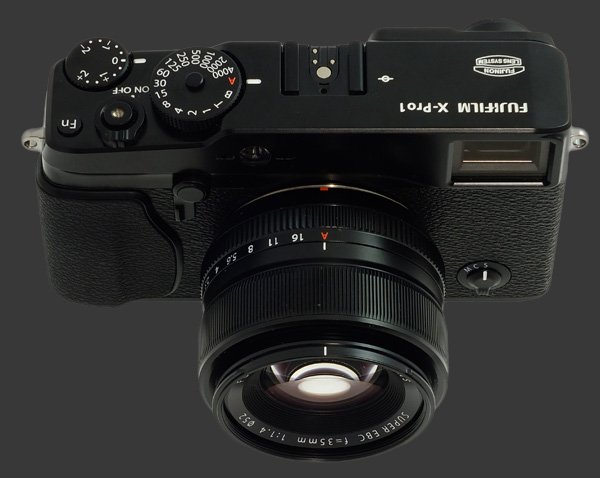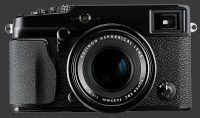Fujifilm X-Pro1 Review
Fujifilm X-Pro1 Performance - How well does it take pictures?
Performance starts with image quality, which is the criteria used as the foundation of our digital camera ratings. Ergonomic issues may get in the way, but in the end, image quality counts the most. For an ILC, image quality greatly depends on the lens used. While color, noise, exposure and dynamic-range are properties of a camera, distortion, vignetting and chromatic aberrations are properties of the lens. Sharpness and contrast depend on the weakest link. That is, a camera cannot capture more details than a lens lets through. Conversely, it is quite possible for a lens to transmit more details than a sensor can capture.
Image Noise & Details
The Fuji X-Pro1 produces images of exceptional quality, exceeded the quality of the very best cropped-sensor DSLR throughout its range of ISO sensitivities, making it even comparable to some full-frame models. Image noise is inexistent all the way to ISO 1600 and becomes barely detectable at ISO 3200. ISO 6400 is almost the same and only at ISO 12800 do some details affected by noise. Still, mid-size prints are possible at such high sensitivity and even at ISO 25600, which is visibly noisy.
The unique X-Trans sensor in the X-Pro1 delivers in terms of sharpness as well. Details are resolved incredibly well even as ISO is increased to 3200. Noise reduction works well with the new color-filter-array and manages to keep images very sharp while removing noise. There are 5 levels of noise-reduction and they extremely close in output quality.
Sharpness is also controllable in 5 levels. Things start from a little soft to tack sharp without adding noticeable sharpening artifacts. This is the first time such a performance is seen and we can only speculate it has to do with the X-Trans sensor and lack of anti-alias filter in front of the sensor. With better data, the sensor can make better images it seems.

Color & White Balance
Color accuracy of the X-Pro1 is very good. Hues are close to reality with different Film Simulation mode mostly affecting saturation. The standard Provia film exaggerates saturation which can be improved by setting Color to -2. Alternately, using Pro Negative Standard film simulation provides a similar rendition of color.
Automatic White-Balance is quite dependable under typical conditions. It handles both natural and artificial lighting surprisingly well, only leave the occasional yellow cast for incandescent and magenta for fluorescent. The Custom White-Balance option is there for difficult situations and is perfectly accurate.
Exposure
Multi-Segment metering produces results of average brightness, very reliably and consistently. It often ignores small highlights which may cause overexposure sometimes. Usually less than one stop EC is required for a better and more conservative exposure. Average and Spot metering work exactly as intended.
Dynamic-Range of the X-Pro1 is relatively good. This can be increased to 200% starting at ISO 400 and to 400% starting at ISO 800 all the way to 6400. This camera handles high-contrast scenes even better than other SLDs but not as well as top-of-the-line DSLRs.
Auto Focus
Without a doubt, autofocus is the weakness of the Fuji X-Pro1. Its Contrast-Detect AF is very slow by current standards and has poor sensitivity. In good light, it is able to lock focus in less than ½s which is sufficient for stationary object but it wont be able to catch something moving. In moderate light, such as typical household lighting, autofocus takes around 1s and sometimes even more.
Continuous AF (AF-C) is not very useful either since it spends a considerable amount of time catching up. It takes roughly 1s for it to refocus in typical indoor lighting, so it struggles with everything that moves. The AF system gives up quicker than usual too, both in AF-S and AF-C mode.
Spot focus, sometimes called AF-On by other brands, lets the X-Pro1 autofocus on-demand while in MF mode. Simply press the AE-L / AF-L button and, ½s to 1s later, focus will usually lock. Manual Focusing is done via a fly-by-wire ring at the front of current XF-mount lenses. Even with the latest firmware, there is a slightly perceptible lag when focusing by manually.

Speed
Except for its sluggish autofocus system, the Fuji X-Pro1 is quick and responsive. Nearly all actions occur without delay. It can also shoot continuous at 6 FPS which is comparable to high-end cropped-sensor DSLRs but notably slower than the latest SLDs from Olympus and Sony. The buffer is capable of absorbing 20 JPEG images or 12 RAW in one burst while using a fast memory card. As no buffer-depth was specified to use by the manufacturer, these numbers were obtained using a Sandisk Extreme Pro 16 MB SDHC card rated at 95 MB/s. The following measurements characterize the performance of the X-Pro1:
- Power-On: Less than 1 seconds. Quite good.
- Power-On to First-Shot: 1 seconds. Very good.
- Autofocus: ½ - 1s, closer to the latter. Very slow.
- Shutter-lag: Immediate with ½s blackout. No blackout when using OVF though.
- Shot-to-shot: Just under 2s with AF, 1¼ in MF. On the slow side.
- Playback: About 3/4s to enter or exist. On the slow side.
- Power-Off: 1½ second, includes sensor cleaning. Good.
- Video: Nearly instant starting and stopping. Better than most.
The performance of the X-Pro1 shows some strengths and limitations. This camera is read to shoot quickly and remains quite responsive. The slow autofocus performance, combined with fly-by-wire manual focus lag makes it not suitable for action, candids and journalism. More stationary subjects, posed portraits and travel in general are not a problem though.
Having a true video mode makes the camera ready to start recording immediately and preview framing correctly. This is a rarity among modern digital cameras, so despite Fuji not having emphasized video in the X-Pro1, it works perfectly. Focus in video can either by continuous or manual. As always, MF is highly recommended for video, even more so because of the back and forth movement required by Contrast-Detect AF.
The Fuji X-Pro1 is powered by a proprietary Lithium-Ion battery which provides 300 shots-per-charge. This is below average and goes down quickly while reviewing images. Another battery is highly recommended not to run out unexpectedly.
Fujifilm X-Pro1 Conclusion

The Fuji X-Pro1 is a technological marvel disguised as a classic rangefinder camera. Underneath its sturdy metal body with plenty of mechanical controls are two unique technologies which make the X-Pro1.A 16 MP X-Trans CMOS sensor which does not require an anti-alias filter and a Hybrid viewfinder which switches instantly between an EVF and OVF.
Image quality of the Fuji X-Pro1 is top-notch and exceeds all current SLDs and cropped-sensor DSLRs by a nice margin. Noise is virtually inexistent until ISO 3200 and only slowly progresses without softness as a result of noise-reduction. Output of this camera is complately usable for mid-size prints until ISO 25600. Sharpness is excellent with both the XF 60mm F/2.4R Macro and stopped-down XF 35mm F/1.4R. The XF 18mm F/2R is still quite sharp, only a tad softer than the other two lenses. Metering, color and white-balance are all very good too.
While the X-Pro1 turns some good performance numbers and is a generally speedy camera, it falters when it comes to focusing. Autofocus speed is sluggish, particularly in typical indoor lighting. It struggles even more in low-light but does shows a reasonable performance in bright daylight.
As the first XF-Mount camera, the X-Pro1 presents a difficult choice. The amazing image quality is very attractive but having a choice of only 3 prime lenses limits photographic potential. Then, of course, there is the question of price with the X-Pro1 being the most expensive SLD on the market by far, pricing itself between top-of-the-line APS-C DSLRs and entry full-frame models. As such seems exactly priced relative to its image quality.
 |
Please Support Neocamera
All information on Neocamera is provided free of charge yet running this website is a huge endeavor. Purchases made via affiliate links found throughout the site help keep it running and up-to-date. There is no additional cost to you, so please consider buying via these links to our affilates:
If you found any information on this site valuable and did not purchase via our affiliate links, please considering donating via PayPal:
Any amount will be greatly appreaciated. Thank you for your support!
Fujifilm X-Pro1 Highlights

Sensor-Size: 24 x 16mm

Actual size when viewed at 100 DPI
| 16 Megapixels Mirrorless | ISO 100-25600 |
| Fujifilm X Mount 1.5X FLM | Shutter 1/4000-30s |
| 0.47" Hybrid EVF 1.4 Megapixels (0.60X) | Full manual controls, including Manual Focus |
| Automatic Eye-Start sensor | Custom white-balance with 2 axis fine-tuning |
| 1 Axis Digital Level | Spot-Metering |
| Built-in Dust Reduction | Hot-Shoe |
| 6 FPS Drive, 20 Images | Lithium-Ion Battery |
| 1920x1080 @ 24 FPS Video Recording | Secure Digital Extended Capacity |
| 3" LCD 1.2 Megapixels |
Updates
2025.01.18

Fujifilm GFX 2025 Lens Roundup
Lens Review roundup of Fujifilm GFX Medium-Format lenses. Quality, performance and handling of the GF20-35mm F/4R WR, GF30mm F/3.5 Tilt-Shift and the GF55mm F/1.7.
2024.11.18

Best 2024 Photography Gifts for Every Budget
Great gifts for photographers and photo enthusiasts selected for every budget among the best products of 2024.
2024.08.07

Eye Protection Tips for Professional Photographers
The four main considerations for professional photographers regarding eyewear.
2024.07.14

Fujifilm X100VI Review
Flagship fixed-lens compact digital camera with a 40 MP sensor and Image-Stabilization, a first for the series. Retro design featuring dual control-dials, plus direct ISO, Shutter-Speed and EC dials. Its hybrid viewfinder can switch between EVF and OVF mode.
2024.05.09

Fujifilm GFX100 II Review
Flagship 102 Megapixels Medium-Format Mirrorless Digital Camera with 8-Stop 5-Axis IBIS, 8 FPS Drive, 8K Video and 400 MP Super-Resolution capture in a weatherproof and freezeproof body with dual control-dials and dual memory-card slots.
2024.04.03

Fujifilm X-T5 Review
Newest Fujifilm flagship boasting a 40 MP APS-C sensor, 5-axis IBIS with 7-stop efficiency, 15 FPS continuous drive, 6.2K Video capture, dual control-dials and dual SDXC UHS-II slots in a sturdy weatherproof and freezeproof body.
2023.11.20

Best Digital Cameras of 2023
Find out which are the Best Digital Cameras of 2023. All the new Mirrorless Digital Cameras from entry-level to high-end professional.
2023.07.10

Fujifilm X-H2 Review
40 Megapixels APS-C Hybrid Mirrorless Digital Camera with 7-stop IBIS. Fastest shutter ever and 8K video capture. Large builtin EVF with 0.8X magnification and 5.8 MP, plus an Eye-Start Sensor. Packed with features and large number of controls in a weatherproof and freezeproof body.
2023.05.07

Sony FE 20-70mm F/4G Review
Review of the unique Sony FE 20-70mm F/4G lens. The optical zoom of this lens spans ultra-wide-angle and medium focal-length coverage, making it one of the most versatile Full-Frame lenses on the market.
2023.01.15

Huion Inspiroy Dial 2 Review
Review of the Huion Inspiroy Dial 2 tablet, a medium sized drawing surface with dual dials and customizable buttons. Connects via USB-C or Bluetooth 5.0 with Windows, Linux and Android support.
2022.12.08

How to Pack for a Photo Trip
Find out how to pack for a travel photography trip, carry your gear safely while meeting airline regulations.
2022.11.13

Best Digital Cameras of 2022
The best digital cameras of 2022. A short list of the most outstanding models in their respective categories. Choose one for yourself or as a gift.












